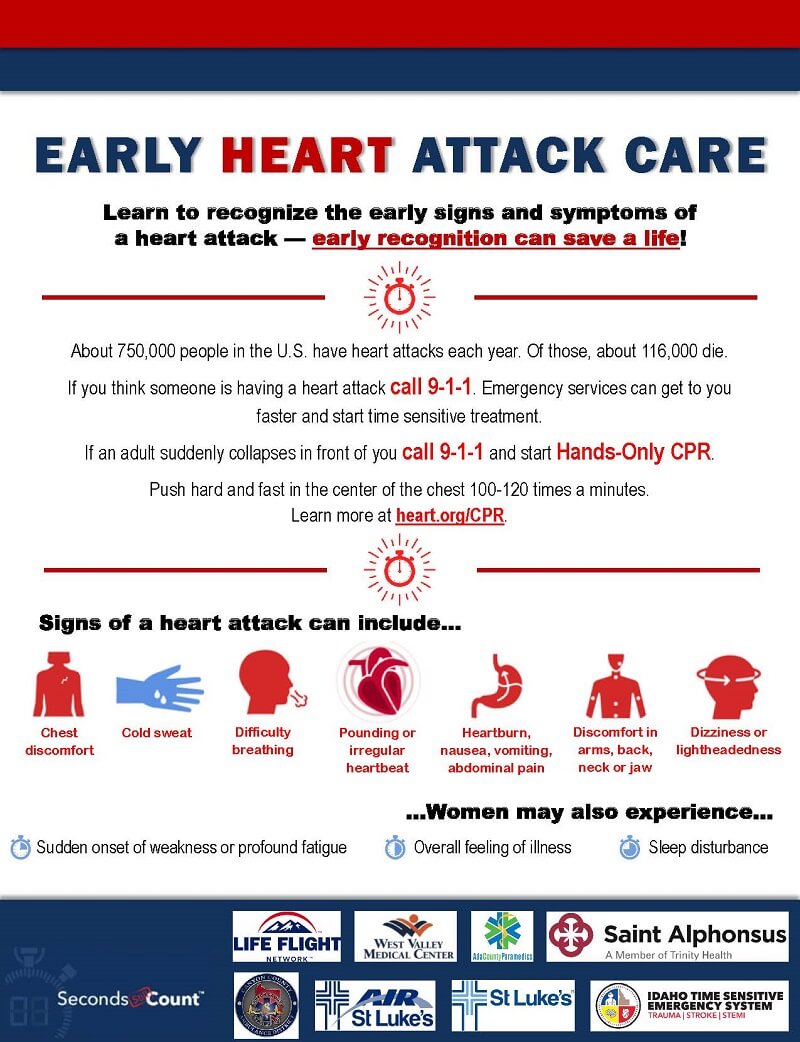Heart disease is the number one cause of death in the United States
Heart disease is the number one cause of death in the United States. It claims more lives than all forms of cancer and lower respiratory disease combined. Each year approximately 1.2 million Americans suffer a heart attack. Nearly one-third of these individuals die, many before they reach the hospital.
Early recognition and action can save you or someone you know from becoming one of these statistics. Know your risk factors and the early signs. Call 911 instead of driving to the hospital. Emergency Medical Services (EMS) can identify and start lifesaving treatments for the most severe types of heart attacks. They can take you to a chest pain center that can provide the required treatments. EMS can notify the hospital before you get there, allowing team members to prepare for your arrival, decreasing any delay. “Seconds Still Count.”
Early Signs of a Heart Attack
- Chest discomfort in the center of the chest that last for more than a few minutes. It may also go away and come back. Sometimes it feels like a pressure, squeezing, fullness, or pain. This discomfort many times is described as “an elephant sitting on my chest” or “a tight band.”
- Discomfort in other areas of the upper body. This may include pain or discomfort in one or both arms, the back, neck, jaw, or stomach.
- Shortness of breath may occur with or before chest discomfort.
- Heartburn, nausea, vomiting, or abdominal pain.
- Other symptoms may include breaking out in a cold sweat, dizziness, or light-headedness.
Heart attacks are often viewed as a man’s problem. However, more women in the United States die from heart disease each year than men. Women may also experience:
- Sudden onset of weakness or profound fatigue.
- Overall feeling of illness.
- Sleep disturbance.
If someone near you experiences the above signs of a heart attack call 911. If they collapse in front of you call 911 and start Hands-Only CPR. Push hard and fast in the center of the chest 100-120 times a minute.
Risk Factors for Heart Attacks
Prevention is the best way to avoid a heart attack. Risk factors such as increasing age, male gender, and family history can’t be changed. Here are a few lifestyle risk factors that can decrease your chances of having a heart attack. According to the Center for Disease Control (CDC) about half of all Americans have at least 1 of 3 key risk factors. They are high blood pressure, high cholesterol, and smoking.
- Don’t smoke or be exposed to smoke.
- Avoid foods high in cholesterol.
- Maintain a healthy blood pressure.
- Prevent or manage diabetes.
- Maintain a healthy weight.
- Get enough physical activity.
- Avoid drinking too much alcohol.
Avoiding key risk factors, early recognition, and calling 911 when someone around you shows signs of a heart attack can save lives. Remember, “Seconds Still Count.”


